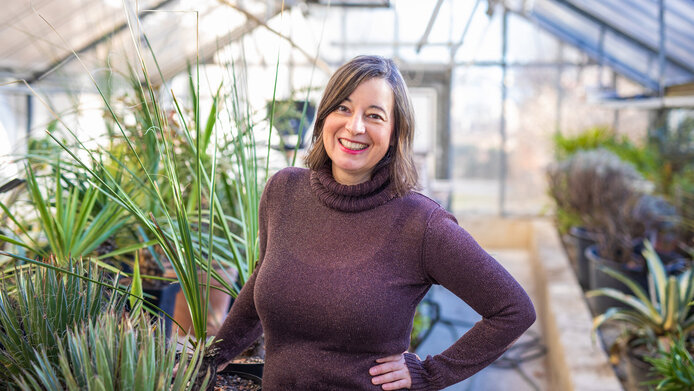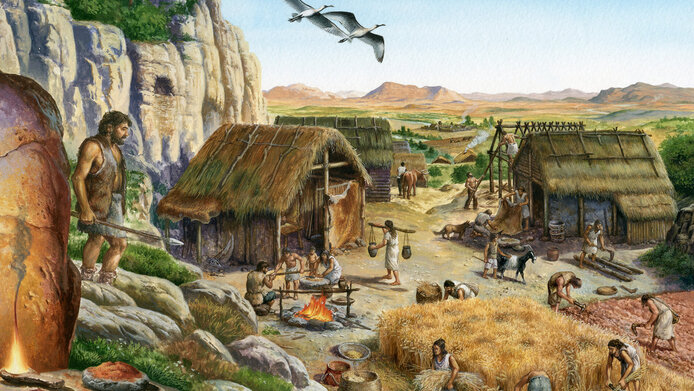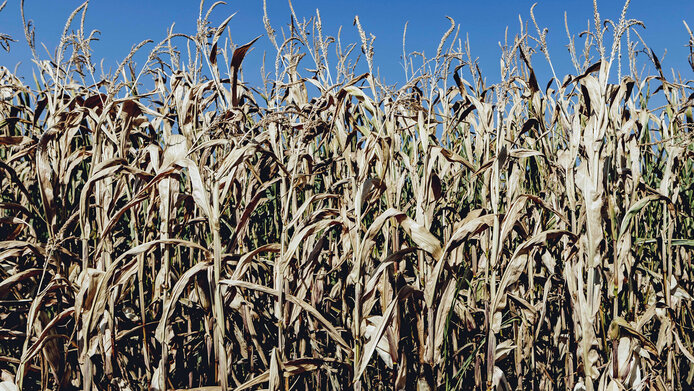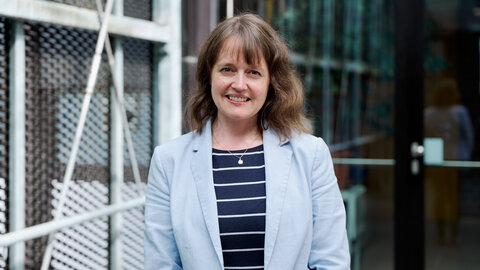Inseparable

About 500 million years ago, the history of planet Earth took a major turn when plants moved to land. This drastic change of habitat from life in the ocean to permanently settling on land was made possible by particular species of green algae from the Zygnematophyceae class – the sister clade of today’s land plants. Step by step, more plants settled on the planet, changing it forever. Without them, there would be no human life. We could not live without the carbon that plants absorb from the air in the form of CO2 and transform into the food we eat, the micronutrients they draw from the soil, and also the oxygen plants emit as a “waste product” of photosynthesis. “Every single carbon atom in every human cell has found its way into our ecosystems through photosynthesis and into our bodies through the food we eat. In this way, plants are the foundation of our food chain. Only in aquatic ecosystems such as oceans and lakes are there micro-organisms that are also involved in photosynthesis, contributing to foods based on fish and other seafood. Apart from potable water, we owe everything we need to live to photosynthesis,” Ilse Kranner stresses.
The head of the Department of Botany at the University of Innsbruck has always been fascinated by plants as a study object. In a research project funded by the Austrian Science Fund (FWF), she studies how plants respond to stress. Her findings are relevant for agriculture, forestry, and the seed industry – and even more so in the context of climate change. After all, stressors such as droughts, rising temperatures, and floods are hard on plants and lead to serious crop failures.
Ilse Kranner heads the Department of Botany at the University of Innsbruck. Her interest lies in the metabolism of plants that are exposed to stress, for example due to drought or flooding. Her research contributes to a better understanding of the consequences of climate change for agriculture and forestry and aims to provide solutions for sustainable cultivation.
The history of humankind: inseparably linked with plants
The way a seed develops, if or when it germinates, has been determined by millions of years of evolution but also thousands of years of cultivating crop plants. “The history of our civilization is inseparably linked with the domestication of plants,” Ilse Kranner says, alluding to the most significant transformation in how humans have inhabited the planet: about 10,000 years ago, hunter-gatherers in the Middle East began domesticating the first grasses. This was the beginning of agriculture and eventually enabled people to permanently settle in villages. Settling down and urbanization – these two steps have shaped humanity to this day; they are the foundation of our civilization.
Thousands of plant species from breeding plants
People started to breed plants by means of a simple selection, which in turn changed them and modified them to match specific conditions. This way, various kinds of so-called landraces formed that are adapted to the conditions prevalent in a specific region. This partnership fundamentally changed both plants and people in a lasting way. The cultivated plants we know today are as far removed from their wild relatives as a Miniature Pinscher from the wolf,” the plant physiologist draws a relatable comparison. The German Genebank located in Gatersleben, where researchers aim to collect samples of all cultivated plants that exist, has about 24,000 genotypes for barley alone, and probably close to 30,000 for wheat, she shares.
How does climate stress affect plants and seeds?
The reproduction of plants ensures food security. In this process, the mother plant conveys all the essential information to the seed: when to germinate, the level of germinating energy, etc. Changes in environmental conditions affect the system’s balance. One such detrimental factor is climate change, which causes crop failures and a change in seed quality. In her research, Ilse Kranner focuses on how changing environmental conditions and the associated stress affect plants and what that means for seeds.
Crop failures and a loss of biodiversity
How long a seed can be stored and how fast and when it sprouts all depend on the information conveyed by the mother plant. The storage conditions also impact quality features such as life span, germination capacity, and germinating energy. Crop failures, which have become more frequent in the past years, not only translate into huge economic losses; they also threaten our food security. When it comes to wild plants, seed quality is also an important factor for maintaining biodiversity.
EcoSeed
“Seed quality is a product of highly complex mechanisms in the mother plant and the seed itself that we are working on decrypting,” Ilse Kranner says. The botanist was the lead researcher of the large-scale international EU project EcoSeed, which focused on four representative crop and wild plants – barley, sunflower, cabbage, and thale cress – in order to investigate what happens to seeds if mother plants experience droughts and rising temperatures during seed development. In a further step, the researchers looked into how storage conditions such as temperature, humidity, and oxygen content during storage impact seed quality. Ideally, the insights gained will also serve the conservation of wild plants. Eleven renowned working groups from all over Europe participated in EcoSeed, among them the world’s largest genebank for wild plants, the Millennium Seed Bank of the Royal Botanic Gardens, Kew, and the EU’s largest genebank for crop plant seeds, the Leibniz Institute of Plant Genetics and Crop Plant Research in Gatersleben.
Drought stress changes the physiology of plants
The results are unambiguous: droughts not only lower seed quality; they have further negative effects. “If plants are under a lot of stress, they shed their seeds or produce fewer seeds, leading to bad harvests and agricultural losses,” Kranner explains. Plants respond to stress factors such as water scarcity by changing their physiology. “Just like people, they are controlled by hormones. During droughts, they find ways to deal with these stressors, for instance closing stomata to prevent water loss while simultaneously slowing down other mechanisms such as those related to pest control,” Kranner explains. This is the reason why hordes of bark bettles can be found on trees during droughts, and why house plants are suddenly teeming with aphids after they have been watered either too sparingly or excessively.
Positive and negative stress
Just like people, plants react to environmental stress factors. According to the biomedical stress model developed by the Canadian physician Hans Selye in the 1930s, there is a difference between eustress (positive stress), which strengthens the organism, and distress (negative stress). The organism undergoes an alarm phase, in which it identifies stress factors, a resistance phase, in which it tries to cope with the stress, and an exhaustion phase, when the stress becomes too much for the organism to handle. These stress phases are not only experienced by people but also by plants. Furthermore, there are abiotic and biotic stressors: abiotic stressors, i.e., non-living stressors, include droughts, floods, heat, cold, and lack of water; biotic (live) stressors are, for instance, parasites.
Seed dormancy for adaptation
Plants have different requirements depending on where they live. In our region of the world, many plants shed their seeds in fall. If these seeds then germinated right away, the seedlings could not survive winter. This is why they go “into hibernation”, a phenomenon called seed dormancy, to wait out the winter and only germinate when it gets warm again in spring.
Stress factors affect the biochemical balance
Seed dormancy is based on a biochemical balance that can be thrown out of kilter by environmental stress – with dramatic effects: gene expressions change, and so does the composition of fats, proteins, and carbohydrates, i.e., all the ingredients of the seeds. “We research how signaling and messenger substances that decide whether seeds lie dormant, germinate, or even die, change,” Kranner says. Will it be possible to resort to landraces from drier regions if temperatures keep rising? “In theory, yes, but it’s not as simple as it sounds,” Karner explains. “First, we would have to see whether we succeed in growing different landraces here. This would take a lot of time, which we clearly do not have considering the pace of climate change.”
A love of nature
Born in the province of Carinthia, Ilse Kranner has always loved nature. Her father, also a nature lover, explained flora and fauna to his daughter on walks in the woods, instilling a love of nature in her. The mother cooked for the family with home-grown vegetables from their garden. Ilse Kranner, who is 58 today, says that she originally wanted to become an “animal researcher” but discovered the beauty of plants when she looked at specimens through the microscope during her biology studies.
Look up at the world around you
After completing her degree in biology at the University of Graz, an APART scholarship of the Austrian Academy of Sciences took her to South Africa, Slovenia, Japan, India, and the US, where she investigated mechanisms for desiccation tolerance together with colleagues. She then moved to the UK for ten years, where she joined the Millennium Seed Bank Project, whose aim it was to collect seeds of ten percent of the world’s seed-bearing plants between 2000 and 2010, i.e., in the first ten years of the millennium. Kranner looks back on this time as formative for her academic career. “I collaborated with colleagues from around the world. Particularly in the natural sciences, you need to look beyond the confines of your own small world.”
Lichen and alpine plants: true survival artists
In 2012, Ilse Kranner was appointed chair at the University of Innsbruck’s Department of Botany. In this role, she has returned to researching high-altitude plants. They are made for dealing with extreme situations: their roots can be planted in the earth at an angle of 50 to 60 degrees, while their shoots and leaves tolerate temperatures below the freezing point. How do they do that? Lichen, a complex symbiosis of fungi and algae, to which Kranner had devoted her doctoral thesis, are true survival artists that populate regions characterized by the most extreme conditions: deserts, alpine regions, the poles. “It’s nothing less than a miracle,” she muses. She is now investigating this miracle in a research project currently funded by the FWF.
Creating awareness for plant protection
Having served on FWF’s Scientific Board from 2014 to 2023, it is particularly important to her to support young researchers as a mentor. She often reminds her students to consider the impact plants have on all life on Earth, calling for a mindful use of our resources. “It is important to me that we treat plants with care, but we should also appreciate what agriculture is doing for us. Because farmers produce what society asks for and needs: more than anything, our food! If we want to become a more sustainable society, we must all change our behavior,” Kranner emphasizes.
Prudent use of our resources
As an example, she mentions the dramatic shift in the value of bread that took place in the past twenty years. Where bread was once considered a source of life and a staple food, overproduction has made it a disposable product often found in garbage cans in the backyard of supermarkets. Many of us are not aware of this development. And the same goes for the tons of other foodstuffs that go to waste. Every single member of our society must become aware of these realities and change their behavior.
Ilse Kranner heads the Department of Botany at the University of Innsbruck. She studied biology at the University of Graz, where she completed a habilitation thesis in 2002. Following an APART scholarship awarded by the Austrian Academy of Sciences, she moved to the UK, where she worked on the Millennium Seed Bank Project for ten years. In her research, she focuses on plants’ stress physiology and their redox metabolism. More than anything, Kranner hopes to shed light on the molecular mechanisms that form the basis of plants’ stress tolerance and their longevity as well as the way seeds age. Her findings are relevant for agriculture, forestry, and the seed industry, not least in the context of climate change.







